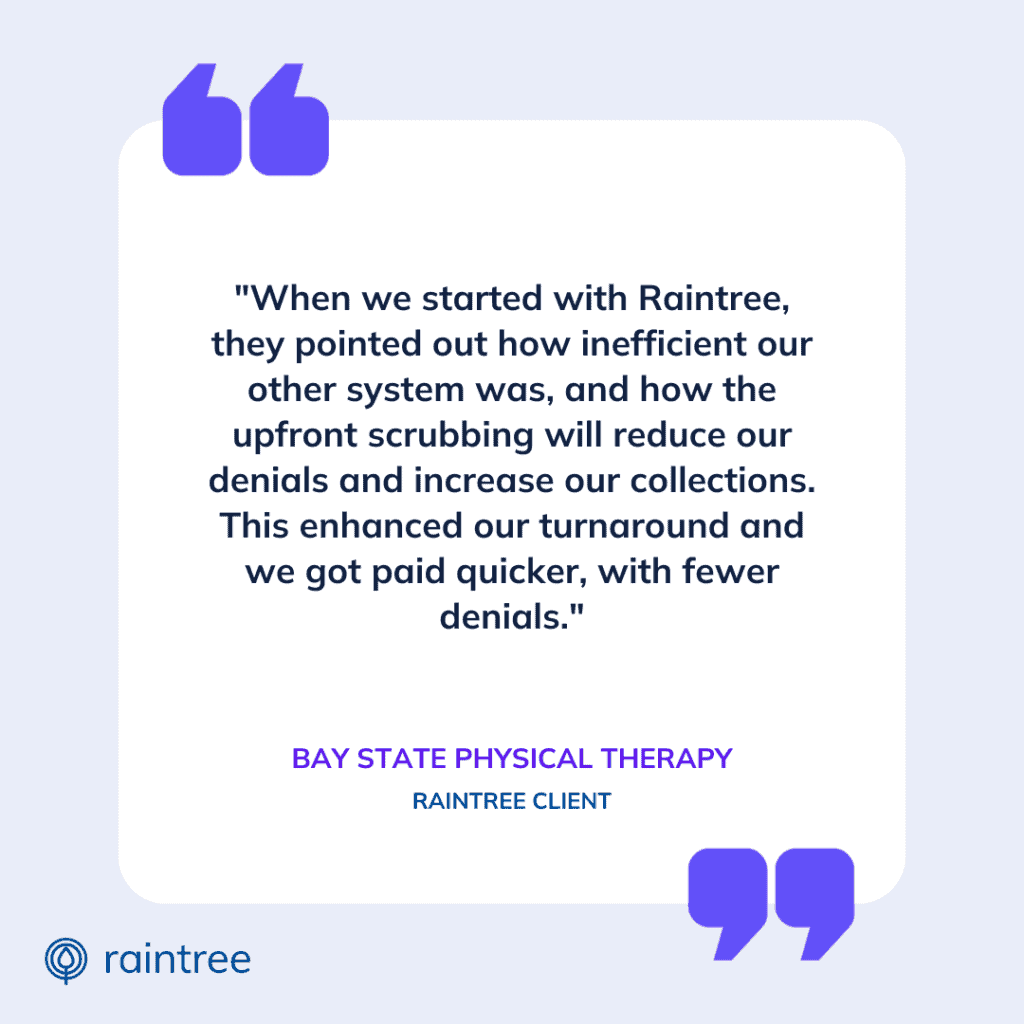It’s estimated that 80% of medical bills contain mistakes, resulting in a loss of about $935 million every week in the US healthcare system.
To stay compliant and reduce errors, medical billers rely on a process called claim scrubbing.
Let’s explore what claim scrubbing is, how it works, and its many benefits—including how the process can prevent seven costly mistakes.
What Is Claim Scrubbing?
Claim scrubbing is, essentially, the process of reviewing submitted claims for discrepancies or errors that might lead to denials. Ideally, patient data and documentation, claims generation, and reimbursements would all line up perfectly. But you probably know that’s not always how it plays out. Here’s a perspective from one of my colleagues:
Billing in the United States is extremely complicated, and that is growing with every passing day. In 2015, ICD-9 became ICD-10, quadrupling the number of diagnostic codes that are available. Those codes are important and they change every year. Then you have your billing codes, the CPT codes and other codes for billing the services [provided]. And those codes have their own definitions.
Veda Collmer, JD, CIPP/US on the Therapy Matters Podcast
Traditionally, claim scrubbing has been a laborious manual process—undertaken by specialized billing professionals or third-party RCM services—to minimize denials further down the revenue cycle. But advancements in medical billing software have transformed the process, bringing it into the modern age.
What Goes Into the Claim Scrubbing Process?
The claim scrubbing process involves examining each claim to weed out potential issues. Squeaky-clean claims depend on:
- Data validation. Checking for missing information, typos, and incorrect formatting.
- Coding compliance. Ensuring codes and billing units are correctly entered, accurate to services rendered, and up to date.
- Medical necessity checks. Verifying the services billed are medically necessary and supported by documentation.
- Duplicate billing detection. Identifying, removing, or preventing duplicate charges.
- Payer rules adherence. Flagging any potential violations of payer-specific rules.
Automated vs. Manual Claim Scrubbing
While, yes, manual claim scrubbing is an option… It’s like using dial-up internet in 2024. It’s time-intensive and still prone to human error. And as your practice grows, the burden of inefficient processes can weigh heavily on your team.
Automated claim scrubbing is simply faster and more accurate. Today, there are many software solutions built to tackle the intricacy of healthcare billing for practices of all sizes and specialties. To sum it up, automated claim scrubbing offers benefits like:
⏱️ Speed and Efficiency
Software can scan hundreds of claims in minutes, freeing up your staff for more valuable tasks.
🎯 Increased Accuracy
Algorithms catch errors human eyes might miss, reducing denials as well as rework.
⚠️ Making Compliance Manageable
Granular and payer-specific rule-setting can align your billing practices with ever-changing guidelines.
📈 Real-time Improvement
Highlighting common errors and trends in claim denials can help you fine-tune your billing practices over time.
🔄 Staying Power
People move on and retire. With scalable software, your billing systems can grow and evolve with your practice.
Related Content:
Claim Scrubbing Best Practices
High-growth practices are built on a strong foundation. Here are some claim scrubbing best practices:
Start With Your Team
Software can catch errors for cleaner claims, but your team is the first line of defense. Training can not only help your billers stay up-to-date on coding changes but also helps them use your software tools more efficiently and effectively.
Remember, though: The process doesn’t start and end with your billing team. Your front office and clinical staff need to pass the baton! Verifying insurance coverage and authorization and following through with detailed and defensible documentation will provide a necessary foundation for clean claims.
Know Your Payers
Following payer guidelines can be complicated, especially for practices that are prioritizing growth or expanding across state lines. Open communication with your clearinghouse and payers can help resolve issues quickly and build strong relationships, organically. As an added benefit, a strong claims submission process can put your practice on good footing with new insurers.
From the Small Details to the Big Picture
Every denied claim has a root cause, but they rarely happen in isolation. Claims monitoring dashboards make it so much easier to dig into denials trends before they become a major problem. If you’re struggling with high rejection rates, your practice may need to invest in processes that help you keep a pulse on your claim statuses, quickly follow up on rejections, and identify patterns.
Avoid These 7 Common Billing Mistakes
Small mistakes can have big consequences. Here are seven common billing mistakes that claim scrubbing can help to avoid:
- Missing or Incorrect Documentation. It just takes one mistake for a claim to bounce back to your desk—from incorrect service dates or diagnosis codes, to invalid insurance member IDs.
- Typographical Errors. Simple typos can be the culprit behind costly claim rejections. Oops!
- Duplicate Charges. Double billing is a red flag for payers, and a headache for everyone.
- Incorrect Coding. e.g. outdated or mismatched codes. And don’t forget to add necessary modifiers!
- Lack of Insurance Verification. Prior authorization and eligibility verification take time, but they pay off.
- Overbilling or upcoding. Billing for services you didn’t provide or misrepresenting time spent with a patient can land you in hot water—AKA revenue loss and regulatory penalties. The short-term benefit isn’t worth long-term consequences.
- Incorrect Final Statement Balances. Does it all add up? Unexpected or surprising bills can lead to disputes, but worse: they erode patient trust.

Claim Scrubbing Software for PT, OT, SLP, and Rehab Therapy
It’s crucial to catch common billing mistakes early, so they don’t bog down your revenue cycle and productivity. Even the little things, like missing or incorrect information, can cause a snag.
By automating the claim scrubbing process with billing software, practices save time, reduce manual hang-ups, and make it that much easier to capture every dollar you’ve earned. Let’s scrub those claims clean!
Raintree Systems helps physical therapy, occupational therapy, speech-language pathology and multi-disciplinary practices grow and succeed with scalable and robust software. Raintree offers the only ONC-certified EHR system designed specifically for rehab therapy. Want to learn more? Schedule a demo and learn why high-growth PT, OT, SLP, and multi-disciplinary practices choose Raintree.

Maria Stearns is the VP of Operations RCM at Raintree Systems, where she oversees revenue cycle management processes and services for hundreds of providers across the US. She brings more than 10 years of experience in leading and managing operations in the medical practice industry, with a focus on improving efficiency, quality, and profitability.


